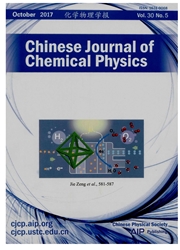

 中文摘要:
中文摘要:
利用团簇模型研究了质子化水团簇对乙炔的溶剂化作用.H+(C2H2)(H2O)n(n=1-5)的量子化学计算结果表明,水分子倾向与乙炔的π电子形成新型OHππ氢键作用,并且乙炔的第一溶剂层需要4个水分子来完成.模拟的红外光谱揭示了OH…π氢键作用后的OH伸缩振动是研究乙炔与水溶剂化过程的灵敏探针.这些红外光谱可以用红外光解离光谱实验方法测得,将为理解OH…π氢键作用以及质子化水团簇如何溶剂化乙炔提供有力的科学数据.关键词:乙炔,水,溶剂化,红外光解离光谱,量子化学计算.
 英文摘要:
英文摘要:
The effect of solvation on the conformation of acetylene has been studied by adding one water molecule at a time. Quantum chemical calculations of the n+ (C2H2)(H2O)n (n=1-5) clusters indicate that the H2O molecules prefer to form the OH...Tr interaction rather than the CH...O interaction. This solvation motif is different from that of neutral (C2H2)(H2O)n (n=1-4) clusters, in which the H2O molecules prefer to form the CH...O and OH...C Hbonds. For the H+(C2H2)(H2O)n cationic clusters, the first solvation shell consists of one ring structure with two OH...Tr H-bonds and three water molecules, which is completed at n=4. Simulated infrared spectra reveal that vibrational frequencies of OH... H-bonded O-H stretching afford a sensitive probe for exploring the solvation of acetylene by protonated water molecules. Infrared spectra of the H+ (C2H2)(H2O)n (n=1-5) clusters could be readily measured by the infrared photodissociation technique and thus provide useful information for the understanding of solvation processes.
 同期刊论文项目
同期刊论文项目
 同项目期刊论文
同项目期刊论文
 期刊信息
期刊信息
